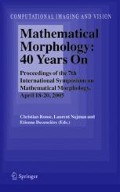Abstract
The watershed transform and seeded region growing are well known tools for image segmentation. They are members of a class of greedy region growing algorithms that are simple, fast and largely parameter free. The main control over these algorithms come from the selection of the marker image, which defines the number of regions and a starting position for each region.
Recently a number of alternative region segmentation approaches have been introduced that allow other types of constraints to be imposed on growing regions, such as limitations on border curvature. Examples of this type of algorithm include the geodesic active contour and classical PDEs.
This paper introduces an approach that allows similar sorts of border constraints to be applied to the watershed transform and seeded region growing. These constraints are imposed at all stages of the growing process and can therefore be used to restrict region leakage.
Access this chapter
Tax calculation will be finalised at checkout
Purchases are for personal use only
Preview
Unable to display preview. Download preview PDF.
References
R. Adams and L. Bischof. Seeded region growing. IEEE Transactions on Pattern Analysis and Machine Intelligence, 16:641–647, 1994.
B. Appleton and H. Talbot. Globally optimal geodesic active contours. submitted to JMIV September 2002, revised October 2003.
R. J. Beare. Regularized seeded region growing. In H. Talbot and R. Beare, editors, Mathematical Morphology, Proceedings of the VIth International Symposium — ISMM 2002, pages 91–99, 2002.
R. J. Beare. A locally constrained watershed transform. Technical Report 04/187, CSIRO Mathematical and Information Sciences, 2004.
S. Beucher and C. Lantuéjoul. Use of watersheds in contour detection. In Int. Workshop on Image Processing, Rennes, France, Sept. 1979. CCETT/IRISA.
E. Breen and D. Monro. An evaluation of priority queues for mathematical morphology. In J. Serra and P. Soille, editors, Mathematical morphology and its applications to image processing, pages 249–256. Kluwer, 1994.
A. Meijster. Efficient Sequential and Parallel Algorithms for Morphological Image Processing. PhD thesis, Institute for Mathematics and Computing Science, University of Groningen, 2004.
F. Meyer. Topographic distance and watershed lines. Signal Processing, 38:113–125, 1994.
F. Meyer and S. Beucher. Morphological segmentation. Journal of Visual Communication and Image Representation, 1(1):21–46, September 1990.
F. Meyer and C. Vachier. Image segmentation based on viscous flooding simulation. In H. Talbot and R. Beare, editors, Mathematical Morphology, Proceedings of the VIth International Symposium — ISMM 2002, pages 69–77, 2002.
H. Nguyen, M. Worring, and R. van den Boomgaard. Watersnakes: energy-driven watershed segmentation. PAMI, 25(3):330–342, 2003.
J. B. T. M. Roerdink and A. Meijster. The watershed transform: definitions, algorithms, and parallelization strategies. Fundamenta Informaticae, 41:187–228, March 2000. ISBN 90-367-1977-1.
J.A. Sethian. Level Set Methods and Fast Marching Methods. Cambridge University Press, 1999.
L. Vincent and P. Soille. Watersheds in digital spaces: an efficient algorithm based on immersion simulations. IEEE Transactions on Pattern Analysis and Machine Intelligence, 13(6):583–598, June 1991.
Author information
Authors and Affiliations
Editor information
Editors and Affiliations
Rights and permissions
Copyright information
© 2005 Springer
About this paper
Cite this paper
Beare, R. (2005). Efficient Implementation of Thelocally Constrained Watershed Transform and Seeded Region Growing. In: Ronse, C., Najman, L., Decencière, E. (eds) Mathematical Morphology: 40 Years On. Computational Imaging and Vision, vol 30. Springer, Dordrecht. https://doi.org/10.1007/1-4020-3443-1_20
Download citation
DOI: https://doi.org/10.1007/1-4020-3443-1_20
Publisher Name: Springer, Dordrecht
Print ISBN: 978-1-4020-3442-8
Online ISBN: 978-1-4020-3443-5
eBook Packages: Computer ScienceComputer Science (R0)

